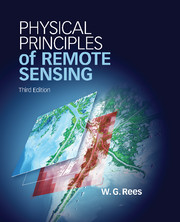Book contents
- Frontmatter
- Contents
- Preface
- Acknowledgements
- 1 Introduction
- 2 Electromagnetic waves in free space
- 3 Interaction of electromagnetic radiation with matter
- 4 Interaction of electromagnetic radiation with the Earth's atmosphere
- 5 Photographic systems
- 6 Electro-optical systems
- 7 Passive microwave systems
- 8 Ranging systems
- 9 Scattering systems
- 10 Platforms for remote sensing
- 11 Data processing
- Appendix Data tables
- References
- Index
- Plate Section
2 - Electromagnetic waves in free space
Published online by Cambridge University Press: 05 December 2012
- Frontmatter
- Contents
- Preface
- Acknowledgements
- 1 Introduction
- 2 Electromagnetic waves in free space
- 3 Interaction of electromagnetic radiation with matter
- 4 Interaction of electromagnetic radiation with the Earth's atmosphere
- 5 Photographic systems
- 6 Electro-optical systems
- 7 Passive microwave systems
- 8 Ranging systems
- 9 Scattering systems
- 10 Platforms for remote sensing
- 11 Data processing
- Appendix Data tables
- References
- Index
- Plate Section
Summary
In Chapter 1 we noted that electromagnetic radiation is fundamental to remote sensing as we have defined it: the information about the sensed object is carried by this radiation. We therefore need to develop an understanding of the essential characteristics of this radiation and of how it interacts with its surroundings. This is a large topic and it is covered in this chapter and the next two. In this chapter we consider electromagnetic radiation in its simplest form, when it is propagating in (travelling through) a vacuum, usually termed ‘free space’. This is practically useful, because for much of its journey towards the sensor the radiation is propagating in a medium that approximates to free space, and it also allows us to develop some of the essential ideas that describe electromagnetic radiation without too much confusing detail.
A particularly important part of this chapter deals with thermal radiation. As we noted in Chapter 1, most passive remote sensing systems detect thermal radiation (in the infrared or microwave regions) or they detect reflected solar radiation. Solar radiation is itself, as explained in this chapter, essentially just another form of thermal radiation, so by developing an understanding of thermal radiation we are able to describe many of the characteristics of the radiation detected by passive systems.
- Type
- Chapter
- Information
- Physical Principles of Remote Sensing , pp. 11 - 41Publisher: Cambridge University PressPrint publication year: 2012



